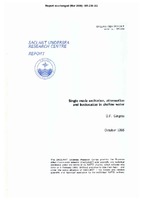| dc.contributor.author | Gingras, Donald F. | |
| dc.date.accessioned | 2018-10-11T14:06:53Z | |
| dc.date.available | 2018-10-11T14:06:53Z | |
| dc.date.issued | 1995/10 | |
| dc.identifier | 2014 | |
| dc.identifier.govdoc | SR-236 | |
| dc.identifier.uri | http://hdl.handle.net/20.500.12489/306 | |
| dc.description.abstract | Normal mode theory is used to illustrate that a vertical array of weighted sources driven in an | |
| dc.description.abstract | appropriate frequency band can be used to minimize the combined effects of attenuation and bottomgenerated backscatter in shallow water. Results are presented for three canonical geoacoustic | |
| dc.description.abstract | models using both a winter and summer sound speed profile. It is shown that through selective | |
| dc.description.abstract | excitation of only mode 1 there exists an optimum frequency band providing both minimum attenuation and minimum bottom-generated backscatter. The results indicate that the center frequency of the optimum band increases as the critical angle decreases. | |
| dc.format | 33 p. : ill. ; 13 fig. | |
| dc.language | English | |
| dc.publisher | NATO. SACLANTCEN | |
| dc.relation.ispartofseries | ADB208381 | |
| dc.subject | Acoustic scattering | |
| dc.subject | Seafloor | |
| dc.subject | Shallow water | |
| dc.title | Single mode excitation, attenuation and backscatter in shallow water | |
| dc.type | Scientific Report (SR) | |
